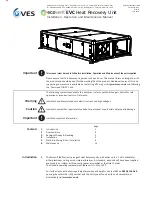
The TEMP display shows the amplifier’s internal temperature as a graph. The indicator lights green
whenever the amplifier is operated in its nor- mal operational temperature range. The indicator
lights yellow whenever the amplifier builds up heat because of continuous high output. However,
since the internal fans provide sufficient ventilation there is no risk of thermal overload in this state.
As soon as temperature indication changes to red, reducing the output level is strongly
recommended. Otherwise the amplifier might cease operation because of thermal overload.
The level controls are for adjusting the overall amplification of the DIRECT IN input signal of the
corresponding amplifier channel. Setting the level controls to a value of 6dB provides full output
capacity. The numerical field below the level controls indicates the set level, by which the output
amplification is attenuated, in dB.
HINT: This level control does not indicate the level of the AEC input, even if the AEC input
routing is selected in the Config&Info window. Use the numerical field available in the
Config&Info window to set the AEC input level.
The MUTE button is for attenuating the output level of the corresponding amplifier output to -∞.
Clicking the MUTE button with the left mouse button mutes the corresponding amplifier output. The
MUTE button is virtually pressed and lights red.
Clicking the MUTE button once again with the left mouse button disables the mute-function and the
amplifier output is again active. The MUTE button is virtually disengaged and not lit.
Clicking this switch activates the STATUS indicator on the amplifier’s rear panel as well as in the
amplifier’s front panel window in the IRIS-Net software. Normally, the STATUS indicator blinks only
during serial communication. Once the STATUS switch is engaged, the STATUS indicator blinks in a
steady but fast sequence. This function is meant for checking communication and for identifying or
searching an amplifier in a large system setup.
The address field indicates the set amplifier address. Assigning a new address is also possible by
clicking into the field with the left mouse but- ton and entering the desired amplifier address.
Available values are 1 to 250. Press Return on the computer keyboard to acknowledge your entry.
The assigned address and the address specified by the setting of the selection switch on the
amplifier’s rear panel have to be identical. Each address can exist only once within a system.
Clicking on the SET button opens the Setup & Control Window, which provides access to all
amplifier- and DSP-parameters, control and monitoring functions plus additional function groups.
The AC LED lights if mains power is available. The DC LED lights if battery power is available.
This soft-key allows switching an amplifier on or off. The STANDBY and POWER indicators signal the
actual operational status.
These indicators show the amp’s actual operational status. STANDBY lights whenever the amplifier
is in stand-by mode. POWER lights whenever the amplifier is powered-on and ready for operation. If
neither one of the indicators lights, the amplifier is either off-line or powered-off.
Config & Info
The Config & Info window provides information and basic settings for the selected amplifier. To select the page click
on the Configuration & Information tab in the Setup & Control Window.
IRIS-Net
PROMATRIX 8000 | en 820
Bosch Security Systems B.V.
User Manual
2017.05 | 3.20 | F.01U.119.956
















































